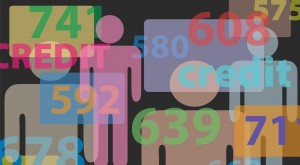Quais são os intervalos FICO Score®?
Quando você está tentando melhorar sua pontuação de crédito, é importante saber como os credores categorizam as pontuações de crédito. Dessa forma, você pode determinar onde o seu deve estar para atingir seus objetivos financeiros.

É ótimo aumentar sua pontuação em 100 pontos, mas se você ainda estiver na categoria “ruim”, ainda não terá muita sorte em ser aprovado para um empréstimo, cartão de crédito ou hipoteca.
Intervalo de pontuação FICO®:300 – 850
Então, como são classificadas as pontuações FICO? As categorias podem variar de acordo com o credor, mas as pontuações geralmente caem da seguinte forma:
Excelente crédito:800 – 850
É mais provável que você seja aprovado para um empréstimo ou cartão de crédito, além de ter acesso às melhores taxas de juros e termos. A pontuação de crédito mais alta que você pode ter é 850.
Crédito muito bom:740 – 799
Você ainda terá algumas das melhores taxas ao solicitar crédito. Na verdade, alguns credores consideram 720 como o limite para as taxas de juros mais baixas, portanto, pode não importar se sua pontuação for maior que isso.
Bom crédito:670 – 739
A pontuação de crédito do americano médio é de 695, que se enquadra na categoria “boa”. Você provavelmente não tem muitos itens negativos importantes listados em seu relatório de crédito, mas há espaço para melhorias para garantir que você obtenha as melhores condições de financiamento.
Crédito justo:580 – 669
Suas taxas nesta categoria definitivamente não serão as melhores disponíveis, o que pode acabar custando milhares de dólares, se não mais, na próxima vez que você fizer um empréstimo ou carregar um saldo no cartão de crédito.
Crédito ruim:300 – 579
Você definitivamente tem alguns itens negativos e pode ter problemas para obter aprovação para crédito, seja um novo cartão ou um empréstimo. Se você for aprovado, suas taxas serão extremamente altas.
A boa notícia é que há muito espaço para melhorias na categoria. A má notícia é que você provavelmente precisará dessa melhoria para ser aprovado para um empréstimo. Por exemplo, a pontuação mínima para um empréstimo à habitação da FHA é 580, portanto, se você definitivamente não for elegível se seu crédito estiver nessa categoria.
Tabela de pontuação FICO®
Você provavelmente sabe onde se enquadra nessas categorias de crédito, mas e todos os outros no país? Com 54,7%, pouco mais da metade da população tem pontuação igual ou superior a 700.
Cerca de 23% das pessoas têm uma pontuação entre 600 e 699, e 22% das pessoas têm uma pontuação inferior a 600. Isso significa que quase um quarto dos americanos tem crédito ruim ou está na fronteira de mergulhar abaixo do limite de 579.
| Muito ruim | Pobre | Média | Bom | Muito bom | Excelente |
| 579 | 619 | 679 | 719 | 779 | 850 |
| 578 | 618 | 678 | 718 | 778 | 849 |
| 577 | 617 | 677 | 717 | 777 | 848 |
| 576 | 616 | 676 | 716 | 776 | 847 |
| 575 | 615 | 675 | 715 | 775 | 846 |
| 574 | 614 | 674 | 714 | 774 | 847 |
| 573 | 613 | 673 | 713 | 773 | 846 |
| 572 | 612 | 672 | 712 | 772 | 845 |
| 571 | 611 | 671 | 711 | 771 | 844 |
| 570 | 610 | 670 | 710 | 770 | 843 |
| 569 | 609 | 669 | 709 | 769 | 842 |
| 568 | 608 | 668 | 708 | 768 | 841 |
| 567 | 607 | 667 | 707 | 767 | 840 |
| 566 | 606 | 666 | 706 | 766 | 839 |
| 565 | 605 | 665 | 705 | 765 | 838 |
| 564 | 604 | 664 | 704 | 764 | 837 |
| 563 | 603 | 663 | 703 | 763 | 836 |
| 562 | 602 | 662 | 702 | 762 | 835 |
| 561 | 601 | 661 | 701 | 761 | 834 |
| 560 | 600 | 660 | 700 | 760 | 833 |
| 559 | 599 | 659 | 699 | 759 | 832 |
| 558 | 598 | 658 | 698 | 758 | 831 |
| 557 | 597 | 657 | 697 | 757 | 830 |
| 556 | 596 | 656 | 696 | 756 | 829 |
| 555 | 595 | 655 | 695 | 755 | 828 |
| 554 | 594 | 654 | 694 | 754 | 827 |
| 553 | 593 | 653 | 693 | 753 | 826 |
| 552 | 592 | 652 | 692 | 752 | 825 |
| 551 | 591 | 651 | 691 | 751 | 824 |
| 550 | 590 | 650 | 690 | 750 | 823 |
| 549 | 589 | 649 | 689 | 749 | 822 |
| 548 | 588 | 648 | 688 | 748 | 821 |
| 547 | 587 | 647 | 687 | 747 | 820 |
| 546 | 586 | 646 | 686 | 746 | 819 |
| 545 | 585 | 645 | 685 | 745 | 818 |
| 544 | 584 | 644 | 684 | 744 | 817 |
| 541 | 583 | 643 | 683 | 743 | 816 |
| 540 | 582 | 642 | 682 | 742 | 815 |
| 539 | 581 | 641 | 681 | 741 | 814 |
| 538 | 580 | 640 | 680 | 740 | 813 |
| 537 | 639 | 739 | 812 | ||
| 536 | 638 | 738 | 811 | ||
| 535 | 637 | 737 | 810 | ||
| 534 | 636 | 736 | 809 | ||
| 533 | 635 | 735 | 808 | ||
| 532 | 634 | 734 | 807 | ||
| 531 | 633 | 733 | 806 | ||
| 530 | 632 | 732 | 805 | ||
| 529 | 631 | 731 | 804 | ||
| 528 | 630 | 730 | 803 | ||
| 527 | 629 | 729 | 802 | ||
| 526 | 628 | 728 | 801 | ||
| 525 | 627 | 727 | 800 | ||
| 524 | 626 | 726 | 799 | ||
| 523 | 625 | 725 | 798 | ||
| 522 | 624 | 724 | 797 | ||
| 521 | 623 | 723 | 796 | ||
| 520 | 622 | 722 | 795 | ||
| 519 | 621 | 721 | 794 | ||
| 518 | 620 | 720 | 793 | ||
| 517 | 792 | ||||
| 516 | 791 | ||||
| 515 | 790 | ||||
| 514 | 789 | ||||
| 513 | 788 | ||||
| 512 | 787 | ||||
| 511 | 786 | ||||
| 510 | 785 | ||||
| 509 | 784 | ||||
| 508 | 783 | ||||
| 507 | 782 | ||||
| 506 | 781 | ||||
| 505 | 780 | ||||
| 504 | |||||
| 503 | |||||
| 502 | |||||
| 501 | |||||
| 500 | |||||
| 499 | |||||
| 498 | |||||
| 497 | |||||
| 496 | |||||
| 495 | |||||
| 494 | |||||
| 493 | |||||
| 492 | |||||
| 491 | |||||
| 490 | |||||
| 489 | |||||
| 488 | |||||
| 487 | |||||
| 486 | |||||
| 485 | |||||
| 484 | |||||
| 483 | |||||
| 482 | |||||
| 481 | |||||
| 480 | |||||
| 479 | |||||
| 478 | |||||
| 477 | |||||
| 476 | |||||
| 475 | |||||
| 474 | |||||
| 473 | |||||
| 472 | |||||
| 471 | |||||
| 470 | |||||
| 469 | |||||
| 468 | |||||
| 467 | |||||
| 466 | |||||
| 465 | |||||
| 464 | |||||
| 463 | |||||
| 462 | |||||
| 461 | |||||
| 460 | |||||
| 459 | |||||
| 458 | |||||
| 457 | |||||
| 456 | |||||
| 455 | |||||
| 454 | |||||
| 453 | |||||
| 452 | |||||
| 451 | |||||
| 450 | |||||
| 449 | |||||
| 448 | |||||
| 447 | |||||
| 446 | |||||
| 445 | |||||
| 444 | |||||
| 443 | |||||
| 442 | |||||
| 441 | |||||
| 440 | |||||
| 439 | |||||
| 438 | |||||
| 437 | |||||
| 436 | |||||
| 435 | |||||
| 434 | |||||
| 433 | |||||
| 432 | |||||
| 431 | |||||
| 430 | |||||
| 429 | |||||
| 428 | |||||
| 427 | |||||
| 426 | |||||
| 425 | |||||
| 424 | |||||
| 423 | |||||
| 422 | |||||
| 421 | |||||
| 420 | |||||
| 419 | |||||
| 418 | |||||
| 417 | |||||
| 416 | |||||
| 415 | |||||
| 414 | |||||
| 413 | |||||
| 412 | |||||
| 411 | |||||
| 410 | |||||
| 409 | |||||
| 408 | |||||
| 407 | |||||
| 406 | |||||
| 405 | |||||
| 404 | |||||
| 403 | |||||
| 402 | |||||
| 401 | |||||
| 400 | |||||
| 399 | |||||
| 398 | |||||
| 397 | |||||
| 396 | |||||
| 395 | |||||
| 394 | |||||
| 393 | |||||
| 392 | |||||
| 391 | |||||
| 390 | |||||
| 389 | |||||
| 388 | |||||
| 387 | |||||
| 386 | |||||
| 385 | |||||
| 384 | |||||
| 383 | |||||
| 382 | |||||
| 381 | |||||
| 380 | |||||
| 379 | |||||
| 378 | |||||
| 377 | |||||
| 376 | |||||
| 375 | |||||
| 374 | |||||
| 373 | |||||
| 372 | |||||
| 371 | |||||
| 370 | |||||
| 369 | |||||
| 368 | |||||
| 367 | |||||
| 366 | |||||
| 365 | |||||
| 364 | |||||
| 363 | |||||
| 362 | |||||
| 361 | |||||
| 360 | |||||
| 359 | |||||
| 358 | |||||
| 357 | |||||
| 356 | |||||
| 355 | |||||
| 354 | |||||
| 353 | |||||
| 352 | |||||
| 351 | |||||
| 350 | |||||
| 349 | |||||
| 348 | |||||
| 347 | |||||
| 346 | |||||
| 345 | |||||
| 344 | |||||
| 343 | |||||
| 342 | |||||
| 341 | |||||
| 340 | |||||
| 339 | |||||
| 338 | |||||
| 337 | |||||
| 336 | |||||
| 335 | |||||
| 334 | |||||
| 333 | |||||
| 332 | |||||
| 331 | |||||
| 330 | |||||
| 329 | |||||
| 328 | |||||
| 327 | |||||
| 326 | |||||
| 325 | |||||
| 324 | |||||
| 323 | |||||
| 322 | |||||
| 321 | |||||
| 320 | |||||
| 319 | |||||
| 318 | |||||
| 317 | |||||
| 316 | |||||
| 315 | |||||
| 314 | |||||
| 313 | |||||
| 312 | |||||
| 311 | |||||
| 310 | |||||
| 309 | |||||
| 308 | |||||
| 307 | |||||
| 306 | |||||
| 305 | |||||
| 304 | |||||
| 303 | |||||
| 302 | |||||
| 301 | |||||
| 300 |
Why Good Credit Matters
It’s important to have a good credit score as high as possible because the higher your interest rate, the more money you’ll pay over time. That can really add up for high-value loans like cars or mortgages.
Let’s look at a quick example. If you have excellent credit and take out a mortgage for $100,000 over 30 years and your rate is a low 3.92%, you’ll end up paying an additional $70,000 in interest payments.
If you think that’s a lot of money, wait until you see the next set of numbers. Bump that rate up to 5.92% for someone with a lower credit score, and they’ll end up paying over $113,000 in interest. That’s more than the loan itself! And it’s $43,000 more than the first person paid with a better interest rate.
The High Cost of Bad Credit
Even if you’re not planning on buying a home anytime soon, the same principles apply to credit cards, car loans, student loans, and other loans. The lower your credit score, the more money you’ll have to pay. Plus, landlords and even some employers now do credit checks as part of their application processes.
With a bad credit score, you might have difficulty finding a home or even a job. And if you have a financial emergency, you might be stuck with high-fee options like payday loans or title loans, which can add up fast and even cost you your car.
If you fall into one of the lower credit rankings, it’s time to start evaluating your credit reports. That way you can find out how you can improve that score and keep your financial opportunities wide open.
Industry Specific Credit Scores
Now that you know what a good credit score is, it’s time to get more specific.
Traditional FICO scores from the popular scoring company Fair Isaac Corporation range from 300 to 850. However, there are actually several credit scoring models that lenders might use when judging your creditworthiness. These vary depending on what type of credit you’re applying for.
A few examples include versions specifically for mortgages, car loans, credit cards, and student loans. Each one will look at slightly different information that is more relevant to the exact type of credit you want.
Your Credit Scores Are Different Depending on What You Apply For
The model for credit cards more heavily weighs your revolving payment history, while the auto-version is going to pay more attention to your past car payments.
There are a couple of tricky parts that come with these alternative scoring models. The first is that you probably won’t know which credit scoring model your lender is going to use unless you ask.
Additionally, the credit score ranges are different from the traditional FICO model. Instead of ranging between 300 and 850, the industry-specific scores range between 250 and 900.
On the auto credit range, for example, you’ll want at least a 750 to get the best interest rates. So, you can see how the numbers vary slightly for each different model.
FICO vs. VantageScore
While FICO scores are the most popular ones used by lenders today, there are other companies competing in this space. The other major model is called VantageScore, which was actually created by the three credit bureaus.
VantageScore 2.0, which is still used by some lenders, calculates credit anywhere between 501 and 990.
The latest version, VantageScore 3.0, uses the same range as FICO to reduce confusion, 300–850. Just like FICO, the higher score you have on both types of VantageScore models, the better a lender views your credit.
What Else Do Lenders Look at Besides Credit Score?
Clearly, your credit score is a massive component of any financial application process. If you don’t meet certain minimums, there’s no way you’ll get approved or access the very best rates. That being said, lenders look at a lot of additional information beyond your credit score and credit report.
They also analyze your income level to make sure you can afford the loan amount you’ve requested. Even if you earn six figures, if you have too much debt or the loan amount is too high, the lender might question your ability to make your payment each month.
Employment History
They also look at your employment history. No matter how great your credit is, or how much money you make, most lenders want to see that you’ve been in the same job (or at least the same industry) for the past two years. They even check your tax statements and pay stubs to confirm your earnings and often require proof of employment.
A lender might also want to know how much in cash reserves you have on hand. They’ll likely want to see bank statements because the more savings you have, the more cushion you have to repay the loan even if you have a financial emergency, like medical bills or a lost job.
How to Get the Best Credit Score
Start by consistently paying all of your bills on time and in full. This is the best thing you can do for your credit score because it accounts for 35%—the biggest factor considered!
You should also order a free copy of your credit report to get an idea of what exactly is bogging down your score. Is there anything on there that’s incorrect or out of date? You might be able to dispute it and have it removed.
In the event you have multiple negative items, you could greatly benefit from talking to a credit repair company to help you clean up your credit history.
Get a Free Credit Consultation
Most companies, like Lexington Law Firm, offer a free consultation so you can ask questions about your specific situation and find out exactly what they can help you with.
Knowledge is power, and finding out your credit score and learning what range you fall in can help you plan the next steps in your financial future.
Never assume the worst-case scenario; there’s no such thing as a lost cause. Everyone, no matter how bad their credit score is, has the potential to improve their financial situation.
It might take a little time and effort, but it’s always doable. Professional credit repair companies that have been in the business for a long time have truly seen it all. Don’t be afraid to give one a call today and find out what you can do to increase your credit score.
Pronto para aumentar sua pontuação de crédito?
Solicite uma Consulta de Crédito Gratuita!
(800) 220-0084Or sign up online>>
bancário
- O que são R1 e I1 no relatório de crédito?
- Quais são as dimensões de um cartão de crédito?
- Quais são os elementos de crédito?
- Quais são as vantagens de pedir dinheiro emprestado?
- Quais são as semelhanças entre bancos e cooperativas de crédito?
- Qual é a pontuação de crédito mínima para comprar uma casa?
- Quais são os diferentes tipos de dívida?
- Qual é a maior pontuação de crédito?
-
 Qual é a pontuação de crédito mais alta que você pode obter?
Qual é a pontuação de crédito mais alta que você pode obter? A faixa de crédito padrão para os modelos de pontuação de crédito mais populares, FICO e VantageScore, é 300-850. Essa faixa levou muitas pessoas a acreditarem que precisam de crédito perfeito para re...
-
 O que é uma pontuação FICO?
O que é uma pontuação FICO? Se você já tentou obter um empréstimo ou solicitou um cartão de crédito, provavelmente já ouviu o termo “pontuação FICO” mencionado em mais de uma ocasião. No entanto, se você está apenas estabelec...


